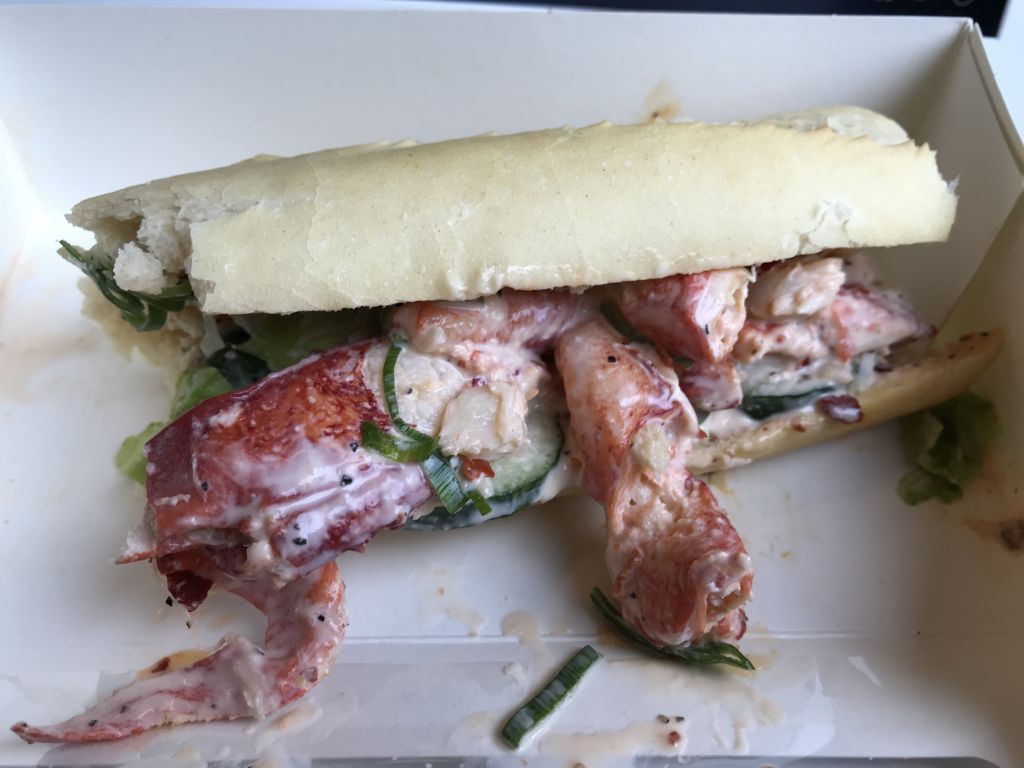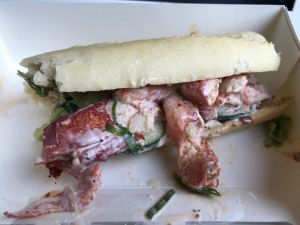Testing Times: In the last issue of reLAKSation, we congratulated Don Staniford for the extensive press coverage he obtained for his weekend protest against salmon farming. We suggested that his pre-publicity was a clever move because if his protest failed to materialise for whatever reason, then he had already managed to get his message across. However, we were interested to see whether his protest actually lived up to his hype or if it did take place, was it just another non-event. We have previously observed his demonstrations in London outside a major retailer that consisted of just a handful of people. This latest protest was taking place in the heart of salmon farming country where according to critics there is widespread opposition. The day prior to his protest, Mr Staniford issued another press release, which provided further information about his plans. This can be viewed on his Typepad website.
What caught our attention most in this press release was that the protest was ‘organised by industry watchdog Scottish Salmon Watch and crowdfunded by members of consumer group SumOfUs’. We cannot find such crowdfunding although it is possible that those who sign their petition are then asked for money. This would explain how Mr Staniford is currently funded, but after last weekend’s event, we wonder whether SumOfUs might want to evaluate their involvement.
In his Press release, Mr Staniford states that ‘This summer, over 43,000 people backed calls by Scottish Salmon Watch and consumer group SumOfUs, for Holyrood to force emergency inspections of salmon farms’. This number was repeated in a comment from Sondhya Gupta, SumOfUs campaign manager in the press release. She said that ‘public outcry at the state of Scotland’s salmon industry is growing with over 43,000 people backing our petition’.
We, at Callander McDowell have previously pointed out how easy it is to get people to sign on-line petitions. The question is how many are motivated to actually take action such as joining the weekend’s protest. Photos of the protest are posted at https://www.smugmug.com/gallery/n-cBLs7r/ and videos can be watched on the Facebook page belonging to Andrew Holder from Extinction Rebellion. As far as we can ascertain, Mr Staniford was the representative from Scottish Salmon Watch present and Sondhya Gupta was the sole member of SumOfUs to attend. We would ask where the other 42,999 people who claim to support their cause?
In all, it seems that there were no more than a half a dozen protesters plus family including Mr Staniford’s two young children who he is always keen to involve in his protests.
The first day of the protest was a bit of a washout due to bad weather. Ms Gupta doesn’t seem to have survived that experience as she did not appear in any of the photos from the second day during which Mr Staniford was towed around in a small kayak trying to collect water samples from near a number of farms.
After the weekend protest, Mr Staniford transferred his protest to Edinburgh. On Monday the 2nd, his press release said to meet at the Government offices at Victoria Quay at 11am. We cannot find any further reference to this except by 11.30, Mr Staniford posted a picture of himself outside the offices with a message that the next protest would be on the following day at the Scottish Parliament. The photo that Mr Staniford posted was actually taken during his previous one-man protest outside Victoria Quay a few months ago. We suspect that the Monday protest did not take place.
Last Tuesday, Mr Staniford was outside Holyrood at 11am. He was there with his two children who were sat on a small kayak in the fountain. Another person dressed in a sea suit was trying to look inconspicuous. We believe that this lady was from OneKind as they had previously Tweeted that they would attend. OneKind object to salmon farming on welfare grounds including the shooting of seals. They have not made any comment about the high number of seals killed as by-catch that we previously reported. Neither has John Robins of Animal Concern who also commented on Mr Staniford’s press release. Mr Robins also runs Save our Seals who might have thought to have been outraged by the high number of seals killed as part of commercial fishing!
The Holyrood protest consisted of Mr Staniford trying to hand in a sample bottle, which he had labelled bio-hazard, to the parliament and being stopped from doing so. Of course, the content, if there was any, was probably just a small amount of sea water and not a bio-hazard at all.
There were a number of photographers present but the absence of any discernible demonstration probably led editors to ditch the story because we have not seen any coverage except from Mr Staniford himself.

He was visited by Green MSP Mark Ruskell who posed with Mr Staniford and his children for a photograph. Mr Ruskell has previously supported Mr Staniford’s efforts whilst at the same time preferring not to engage with the salmon farming industry.
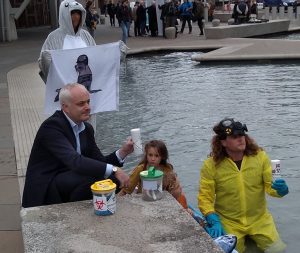
By coincidence, his colleague Mr John Finnie MSP, who is also a member of the Parliamentary REC Committee recently called again for a moratorium of expansion of the industry in the local press. Interestingly, at the same time, four members of the REC Committee visited a farm on Skye, but Mr Finnie was not one of them. In our opinion, there is an unwillingness of industry critics to engage with the industry to discuss concerns face to face.
We contacted Sondhya Gupta offering her a coffee and a chat. She replied, ‘Thanks for the offer but I’ll decline’.
Yet again we have seen the press give widespread publicity to anti-salmon farming critics and yet again, we have seen that those prepared to take such action amount to about the number of fingers on one hand. It seems to be more about getting PR rather than telling the truth.
Finally, we were interested that the fountain outside the Scottish Parliament received more publicity this week through the BBC than Mr Staniford achieved for his protest paddle – https://www.bbc.co.uk/news/av/uk-scotland-49582760/cyclist-falls-into-water-during-sarah-smith-s-live-news-report
Sowing Doubt: Salmon industry critic Corin Smith writes on his Facebook page that there is an overwhelming majority in every country where open pen salmon farming operates that are opposed to its existence. Does he mean the handful that turned up near Oban to protest? We could ask that given his ongoing criticism of the industry, why didn’t he and his fellow members of Salmon & Trout Conservation turn out to support Don Staniford? We wouldn’t be surprised if they were all out on Scotland’s rivers trying to fish for wild salmon.
Mr Smith also writes of the paid for PR from the farmed salmon lobby that uses tactics similar to that of the tobacco industry to confuse and sow doubt. We know he can’t mean us because we are certainly not paid for and we are not a PR company. Does he mean the members of the SSPO because how are they any different to members of Salmon & Trout Conservation, of which Mr Smith is part.
Mr Smith was repeating a similar claim about salmon farming being akin to the tobacco industry made by the North American Sea Shepherd Conservation Society, whose video Mr Smith has posted on his website. Sea Shepherd say that they are working to save the Pacific wild salmon from the devastating impacts of open net pen salmon farming but that the salmon farm industry misleads and misinforms. We would disagree. In our experience, anything we say that doesn’t fit the critics narrative is always claimed to mislead and misinform. Unfortunately, as we repeatedly say, these critics, whether environmentalists or anglers, refuse to discuss the issues so they can never really judge anything we might say.
In this issue of reLAKSation we would like to consider a news report that appeared on the CBC Canada website. This says that a new genetic study of sockeye salmon from the Skeena River suggest that stocks have declined by 75% since 1913. The study was made possible by the discovery of a collection of salmon scales from fish caught by fishermen since 1912. The resulting study is published in the journal, Conservation Letters, (https://conbio.onlinelibrary.wiley.com/doi/full/10.1111/conl.12669) used genetic tools to trace the historical trends in Sockeye salmon. They estimate that numbers of fish have dropped from about 1.8 million to 469,000 over the last hundred years. The authors say that this rate of decline is much greater than revealed by studies covering the period 1960 to present.
What is clear from this study is that wild salmon populations in Canada are likely to have been in long term decline for decades and certainly long before the appearance of salmon farming in BC. Equally, these declines have occurred in rivers which are located many miles from the nearest salmon farm.
One explanation for the decline in the Skeena is that selective fisheries may be a major factor. This is because those fish populations with the largest body size have decline the most.
The video posted by Sea Shepherd looks at some of the work being undertaken to show whether salmon farms are damaging to the environment. Reference is made to the fact that the science should be considered not opinions. The video says that it is important to take note of the science because ‘you do not want to happen what has happened on the Atlantic coast’ when the science wasn’t acted on. There was knowledge that cod stocks were in trouble and then those stocks collapsed. ‘This is a lesson that we should reflect on’.
The question is what knowledge was known about cod stocks. This was that modern fishing techniques quickly depleted stocks at a faster rate than ever envisaged. Simply cod were fished to extinction.
Although not as profound, clearly, stocks of sockeye and other Pacific salmon have been repeatedly harvested over many years in large quantities. Wild salmon numbers are not infinite so inevitably, stocks will decline just as cod stocks did.
Sadly, Sea Shepherd appear reluctant to take note of their own video and see that commercial fishing has had a major impact on the size of wild fish stocks for many years. Yet, it is still easier to blame salmon farming than address the real problem.
The Star in Vancouver recently reported that the First Nations want sports fishing closed down to save Chinook salmon stocks in the Fraser River. The paper reported seeing more than 120 recreational boats most with three or four rods before 9am one Saturday morning. The fact is that there is heavy fishing pressure on many Pacific salmon stocks. Like east coast cod stocks, there is only one outcome.
No doubt we will be accused of confusing the issue of impacts by salmon farming but really the problem is a willingness to deflect all the problems of the wild fish sector at salmon farming’s door.
Artifishal again: The Patagonia film Artifishal is still doing the rounds and this week was shown in Fort William. Those promoting the film said that it was a sell-out, yet the photograph of the event shows about 40 people and apparently a number of those were from the salmon farming company Mowi.
A comment was made on the relevant Facebook page that ‘the Mowi mob seem to be in denial of the environmental disaster they have created’, to which someone asked if ‘Mowi were out in force? The response was that ‘they were indeed, and they rather dominated the conversation’. Finally, someone else ‘wondered how the Q&A would have gone without their domineering presence.’
As regular readers will know, we attended the premiere of the film and were specifically asked not to disrupt the meeting with difficult questions. So we sat quietly and listened to the repeated unsubstantiated claims. We regret not speaking at the time and it is right that there should be a debate rather than hearing their one-sided account. Unfortunately, as we know, most industry critics are extremely reluctant to engage in a debate. The comments following this showing of Artifishal just reflects this unwillingness to listen to anything other than their extremely biased point of view.
A lunchtime roll: In a change of mood and subject, on a recent trip north we bought a limited-edition lobster roll from Pret a Manager for lunch.
The lobster roll appeared in stores in June and consisted of ‘sustainably sourced’ Maine lobster dressed in lemon and chilli mayonnaise and served in a white baguette with cos lettuce and cucumber. The lobster roll had been a success in US stores when they appeared there last year so has now made an appearance here in 123 stores.
The lobster roll cost us £6.29.
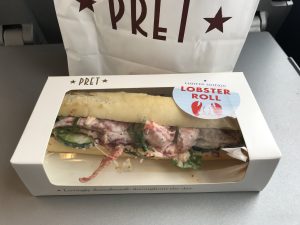
It certainly made a lovely change from the usual sandwich. It was well filled with lobster, which certainly wasn’t hidden away under the lettuce. The mayo gave a bit of a kick but did not disguise the flavour of the lobster. If there was a bit of a let-down it was the baguette which was a bit chewy.
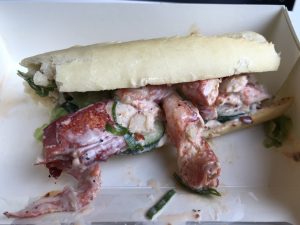
We suspect that now the summer has gone, the Lobster Roll will go too. We hope to see it again next year.

